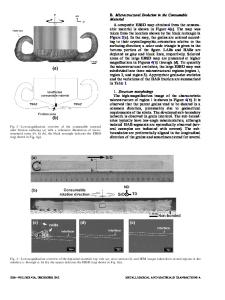Microstructural and compositional evolution of compound layers during gaseous nitrocarburizing
- PDF / 1,481,282 Bytes
- 17 Pages / 612 x 792 pts (letter) Page_size
- 13 Downloads / 340 Views
I. INTRODUCTION
NITROCARBURIZING is a thermochemical surface treatment during which nitrogen and carbon are supplied simultaneously to a steel surface at temperatures usually between 823 and 853 K (550 8C to 580 8C). Provided that the nitrogen and carbon activities imposed by the nitrocarburizing agent on the steel surface are sufficiently high, a compound layer consisting predominantly of « and/or g8 phases is formed at the surface of a ferritic steel. In the region underneath the compound layer, the so-called diffusion zone, for pure iron, N and C atoms from the gas mixture are dissolved interstitially in the ferrite lattice at the nitrocarburizing temperature. The compound layer has an interesting combination of wear and atmospheric corrosion performance. The diffusion zone brings about an improvement of the endurance limit as compared to an untreated component.[1] Hence, nitrocarburizing is perhaps the most versatile surface treatment for ferritic steel and has a potential for wide application. Fundamental investigations on the characteristics of the compound layers formed on pure iron during gaseous nitrocarburizing have been carried out by several authors.[2–5] However, the actual activities of nitrogen and carbon imposed by the nitrocarburizing medium were not analyzed during those experiments. The purpose of the present study is to investigate the microstructural and compositional evolution of compound layers on iron and on iron-carbon substrates during gaseous nitrocarburizing with controlled HONG DU, formerly Ph.D. Student, Department of Materials Science and Engineering, Royal Institute of Technology, is Research Engineer, United Technologies Research Center, East Hartford, CT 06108. MARCEL A.J. SOMERS, formerly Assistant Professor, Laboratory of Materials Science, Delft University of Technology, NL-2628 AL Delft, The Netherlands, is Professor of Metallurgy, Department of Manufacturing Engineering, The ˚ Technical University of Denmark, DK-2800 Lyngby, Denmark. JOHN AGREN, Professor of Physical Metallurgy, is with the Department of Materials Science and Engineering, Royal Institute of Technology, S-10044 Stockholm, Sweden. Manuscript submitted August 4, 1998. METALLURGICAL AND MATERIALS TRANSACTIONS A
nitriding and carburizing potentials. Various gas compositions were used in order to examine their influence on the microstructural and on the compositional evolution and the growth kinetics of the compound layer. The influence of carbon initially present in the substrate on the microstructural and compositional evolution and on the growth kinetics of the compound layer was evaluated from comparing the results obtained for an Fe-0.8C alloy with those for pure iron under identical nitrocarburizing conditions.
II. THERMODYNAMICS OF NITROCARBURIZING The nitriding and carburizing potentials imposed on a specimen surface by the nitrocarburizing gas mixture can be represented by the nitrogen and carbon activities that would occur in a solid solution if chemical equilibrium exists between N and C in the gas mixt
Data Loading...











